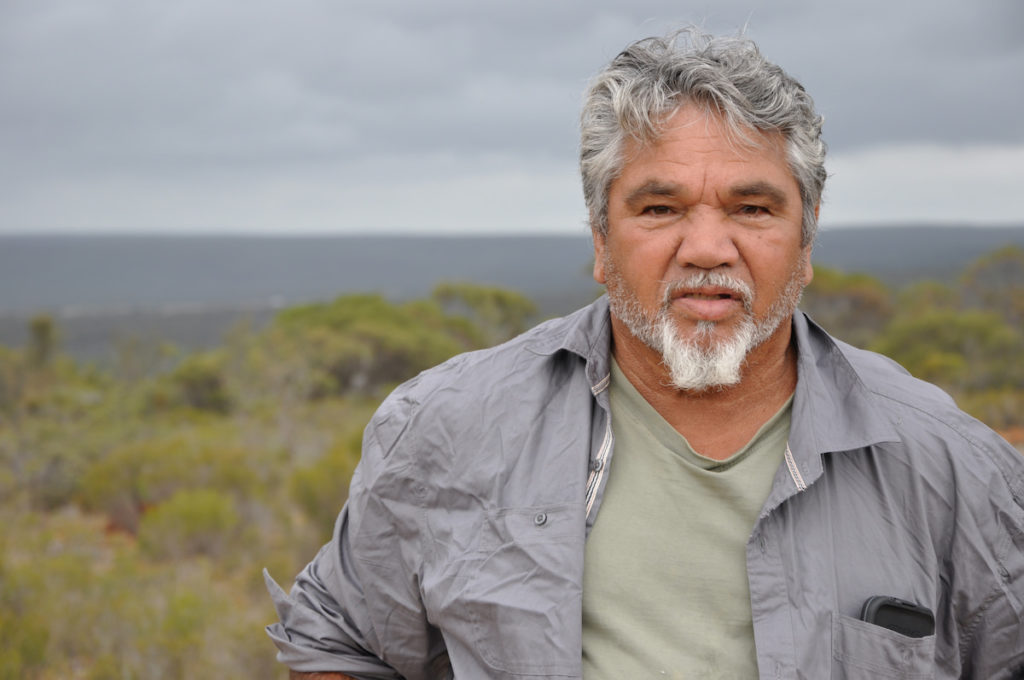Eugene Eades: Coming back to Country
January 2022
Nowanup is a key plank in the 1000 km long Gondwana Link effort to restore bush and support the ambition of First Nations people to reconnect with country. This third story in Gondwana Link’s HEARTLAND JOURNEYS series is focused on the transformative work taking place at Nowanup under the leadership of Eugene Eades. Eugene is a Goreng Noongar Elder, and since 2006 he has played a pivotal role in creating a powerful healing and cross-cultural gathering place on this former farm, which lies to the north-east of the Stirling Range.
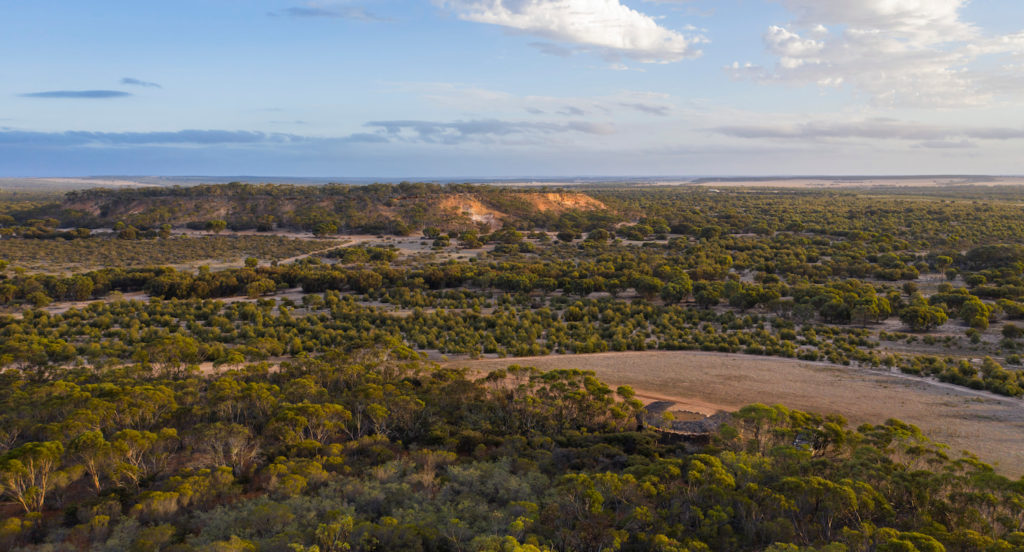
Gondwana Link: Eugene has used his extraordinary leadership skills and dedication to help make Nowanup a beacon of hope. He has led hundreds of camps and welcomed 1000s of people to Nowanup.
In this story, Eugene tells us a little about himself and Nowanup’s history, and the vision that drives the work being done there.
At the core of Eugene’s story is the need to come back to Boodja (Country). To do that he had to learn from the Elders and acknowledge all the Elders who came before.
Eugene Eades: You got all this beautiful country where in the past Noongars lived and marriages took place, ceremony took place, law was handed down, and the culture was in full swing. You’re looking back to a time when there was no Red Rooster, there was no Hungry Jack’s, there was the six seasons. And just how beautiful it was for the Elders to have this set of protocols that kept everybody in check.
I actually made a strong stand in my life that I must respect my Elders, women and male. No matter what, they’re my bosses and Nowanup was a classic example of that. Everything that’s been done here and achieved hasn’t been done by Eugene Eades making a decision by himself, it’s been done under the instructions that were given to me by the Elders all the way through. I just can’t acknowledge and thank them enough for the journey we’ve been on; for what they’ve put into my life.
My memory is of coming to Nowanup in 2005 and being told by our great man leading the way with Gondwana Link, Keith Bradby, he said something to the effect that “The gates were open ‒ Noongar boodja. On Noongar country do what you need to do that’s going to bring a change for the better for your people.” These are some of the results of that invitation that came by way of a shake of the hand, and we’ve been doing it ever since. It’s been a wonderful journey.
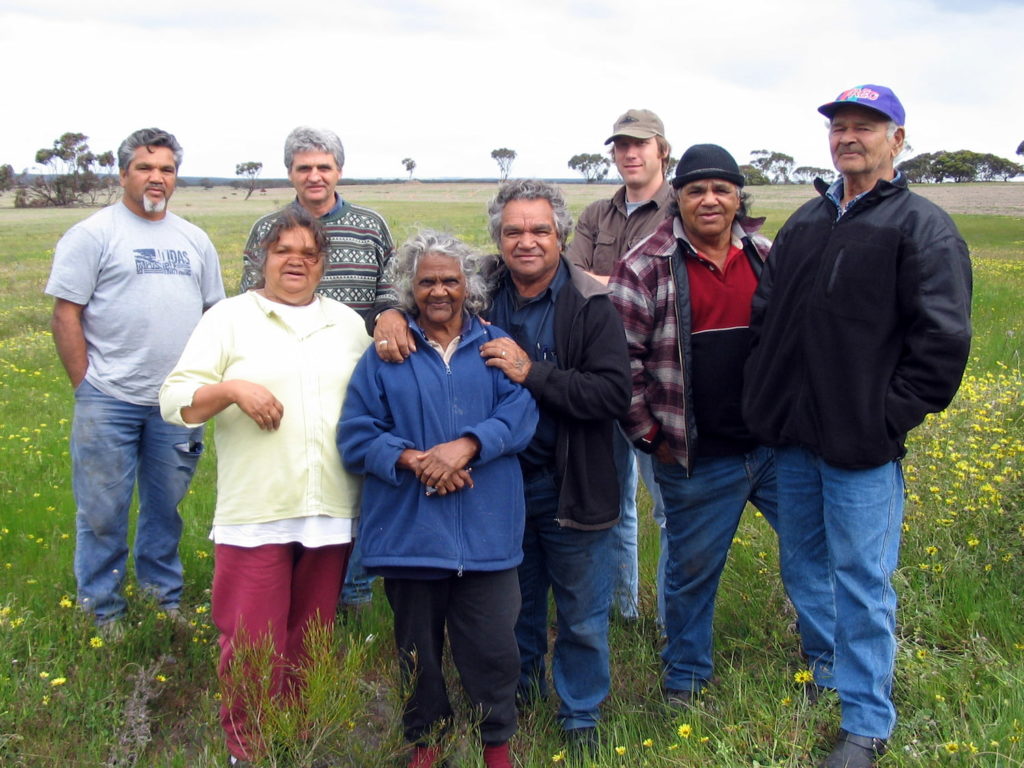
GL: Keith’s invitation followed the purchase of the 754-hectare Nowanup property, now owned by Greening Australia. In 2006, under the direction of his Elders, Eugene co-ordinated the design and build of a special Meeting Place, working with a group of young Noongar men and other key helpers.
Under Eugene’s leadership, collaboration to support a Nowanup cultural program has grown between Greening Australia, Gondwana Link, the Noongar community and Friends of Nowanup. Today, a wide range of activities are underway, including cultural plantings on some of the cleared land.
Since 2015, a Nowanup Ranger team has focused on the management of Nowanup, as well as habitat plantings and other landcare works across a wider area.
EE: The energy is starting to flow back to the land, starting to flow back to the people, changing lives amongst wadjela [non-Indigenous] and Noongar. People are coming together as one. You know, it’s just the way the world’s meant to be: no white, no black, all the same. So it’s become a learning place: the Bush University, Nowanup, Boodja.
We can’t do the things we need to do that will make a difference to our people unless we’ve got the land, the Boodja, and right now we’ve got the Boodja, tuning it up, healing it.
We’re not only healing the land we’re creating habitats and ecosystems for endangered species of animal and bird life.
GL: On Nowanup some 340 hectares of formerly agricultural land has been revegetated and Eugene has been there to witness the country coming back to life.
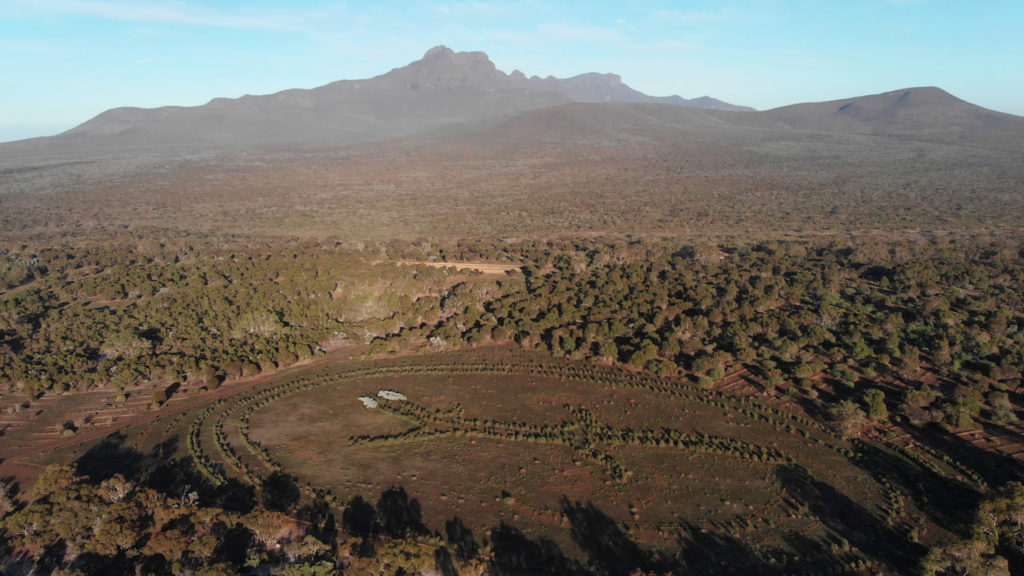
EE: This is where all the healing of the land has taken place. Back in 2005, sheep were running around there. You can be lucky on some mornings to see the emus and the little ones running through, and the kangaroos feeding — they’re back on the land. And while that’s all happening you got us as Noongars now, we’re coming back to land too, to be that caretaker and play that role that used to be there. The Boodja is calling us back. The mother earth is calling us back to take up our rightful roles and responsibility of caring for the land and caring for sites of cultural significance.
So it’s just like the old people said, you know, we are part of the land, we are part of the animals, we’re part of the bird life, part of the waters, the rivers, and it’s a part of us.
We’ve got a program running now: ‘Healing Land, Healing People’. If we heal the land, the land becomes healthy again. Then if we hang around long enough in that same space, we’re going to become healthy as well. And if we’re healthy and the land’s healthy, then we can make decisions that suits the land, but also suits ourselves, without destroying it.
Put the Noongar back in his rightful roles of caretaker and caring for country and managing the place and we willfind out quickly how it all works. And we just adapt it into our way of life as well, which is like the old way becoming the new way, quite simple.
GL: The story of connecting back to Country is a very personal one for Eugene.
EE: I like to be on my own a lot because I meditate deep, deep, deep, deep. I try and leave my body sometimes, I think, to make sure I’m looking in the right places without myself watching [chuckles], something like that, yeah.
I’m a strange sort of a bloke, I’m a strange sort of a Noongar bloke. I think it is not really normal, what I do. Course, lots of people, including my Noongar mob, a lot of them say “Euie, you’re allowed to come back into town, you’ve been out there for too long”.
But I’m connecting back to the land and I’m connecting back to my true spirituality and my totems, my moiety, and I’m gaining a good understanding and a good relationship with the land.
I must say there’s been some challenges along the way – had to live on a bit of roadkill for a while there. But, you know, that’s part of the journey.
Having the opportunity to come out and work as a cultural advisor, linking up Noongar families with connection to country and seeing the reactions, and working to restore the dignity into the lives of older people that have been forcibly removed from these places under some government policies of the past, to see them light up like Christmas trees is an indication that there’s a great energy out here within the land. Noongars call it mabarn. It’s a power, it’s an energy that was used to make unwell people well again, and seeing the people that come here, whether they’re non-Aboriginal or Aboriginal, always go away feeling much better than when they came.
Once upon a time in the past, we had lots of these people like myself that took people out and restored their health and wellbeing back to normal.
What’s been happening out at Nowanup is that I love going to places where the hairs on your body stand up. I love going to those places. I think they’ve got more to offer us than the places where it’s not like that. So I’ve been seeking and searching for those locations throughout the land. Found a lot of them. And I wanted to test my stamina, my staying power; test my faith.
This place has got an energy in it which, ahh, I’m finding it hard to find another place like it.
GL: Since 2006, over sixteen thousand Noongar and non-Aboriginal people have visited Nowanup, mostly through camps and cultural programs. These camps and programs have focused on Noongar families and youth-at-risk, schools, universities, cross-cultural sharing, and language workshops. For Eugene, the significance of Nowanup extends across all cultures. He has seen first-hand how powerful the collaboration and connection to country can be for everyone.
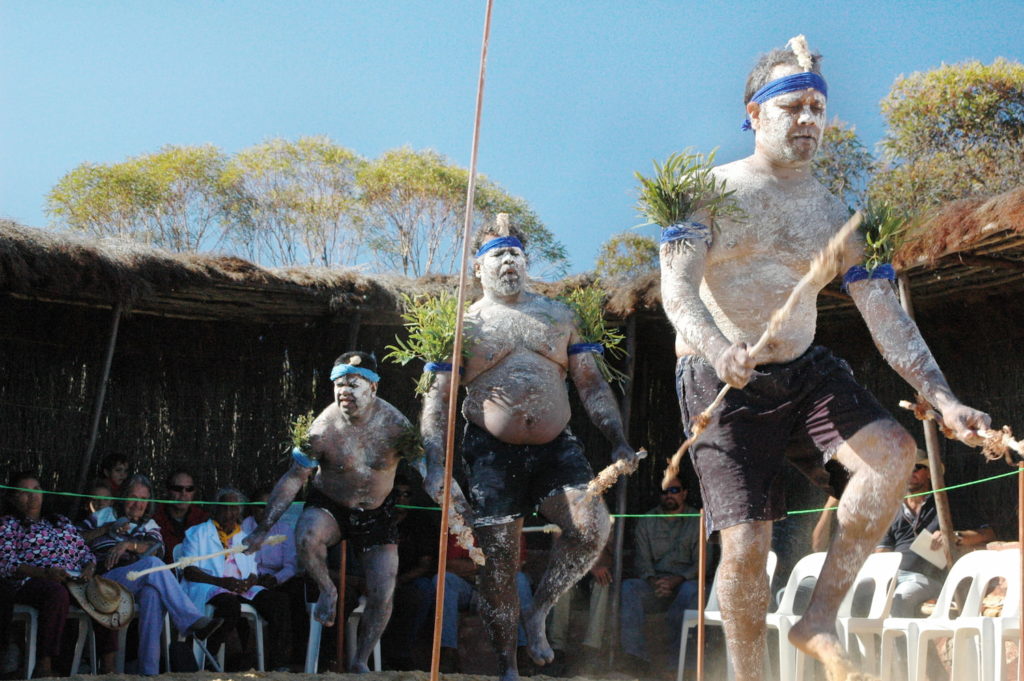
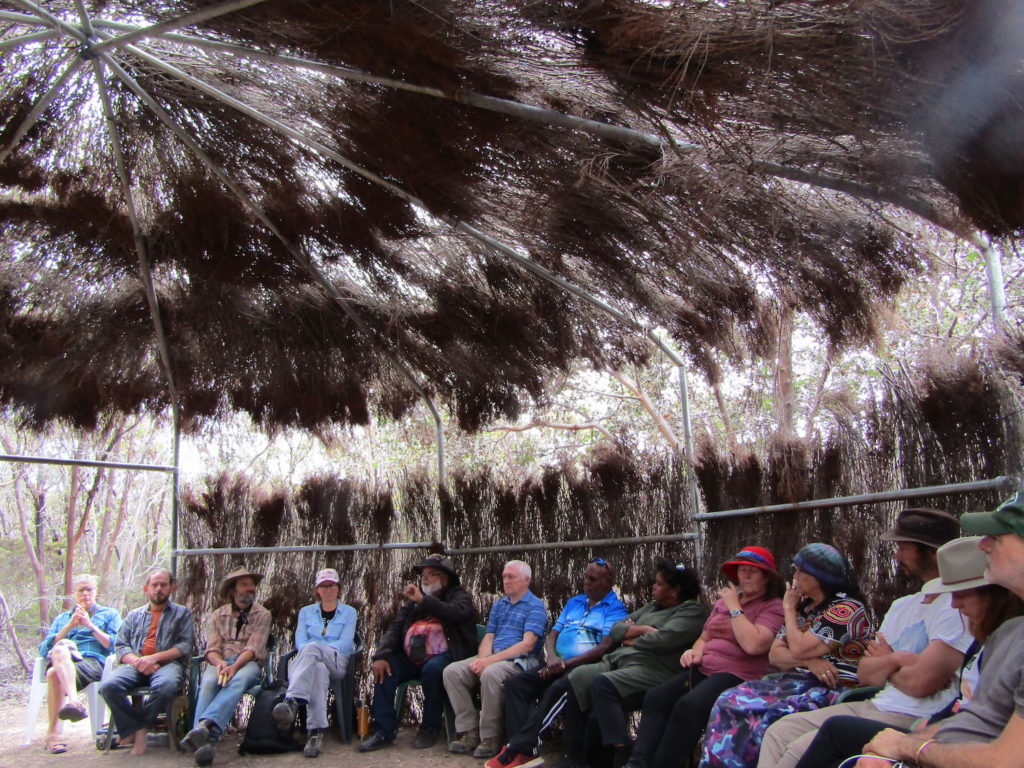
EE: Many cultures come here from many parts of the world and for me to hear some of their stories, you know, it’s been just so encouraging and it stokes your fire up to raise your bar to another level for your people and those that you work in partnership with. It’s been a joy.
I’d like to see something in a big story that would actually wake up the whole of the world. Not hear a story about my people and our Noongars, but a story about how we’ve come together from all walks of life to this Meeting Place that was built by some very unwell people from the past and, through their efforts, established something where we can come and talk business or have the same vision of following the same dream.
I think in a wadjela way I’d like to see this multicultural, geographical story about Nowanup and the energy that comes here and is left here by visitors from all over the world, who have the same interests as each other, and share that in a powerful way to many, many people from all walks of life, from all sorts of backgrounds with all sorts of problems — and for all those who reckon they haven’t got problems as well; I think they may need more help than the unwell people. And I think it’s about people becoming educated in the right way, where the land teaches us, not us teach the land. We’ll go back to those days of relying on the animals, the birds and nature and how it speaks to us.
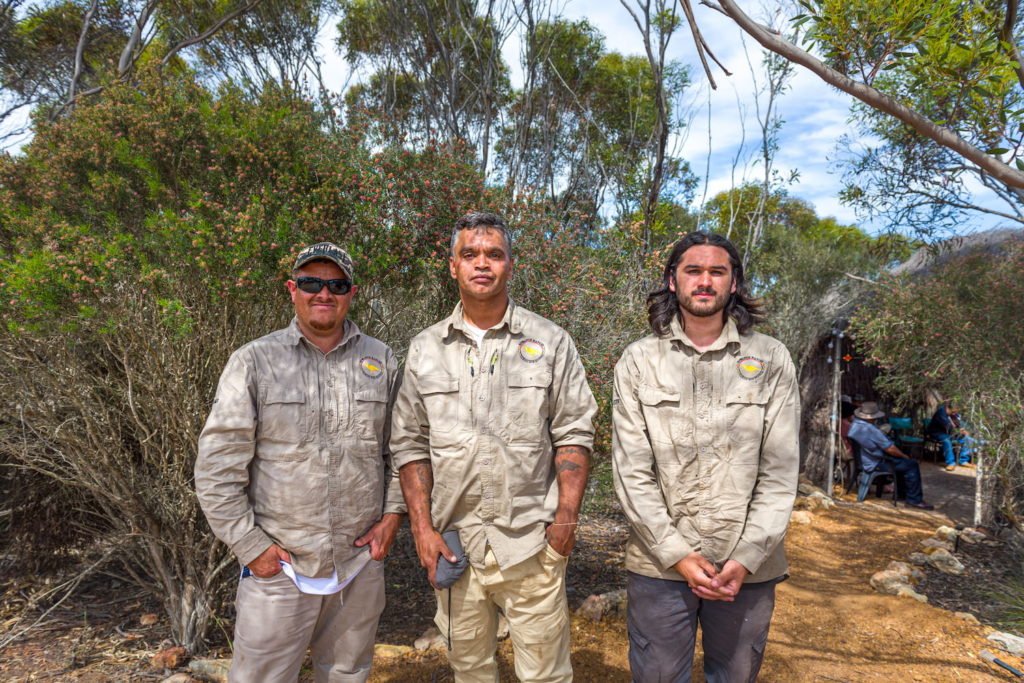
I look across the distance over there – those paddocks – my way of reading that is it’s like the mother, the Boodja. The Boodja’s got its hands up like this here, and its saying “Help me. Help me. I need your help.” Yeah? “My days are numbered”. Yeah? So we’re gonna make them patches become like those green patches. All those old burnt patches and dry country are going to become green and healthy again.
GL: In recognition of his skill, commitment and ongoing work with a wide range of students, in 2019 Eugene was appointed an Adjunct Associate Professor at Curtin University.
Thanks to Frank Rijavec and Margaret Robertson for the original recordings of Eugene.

